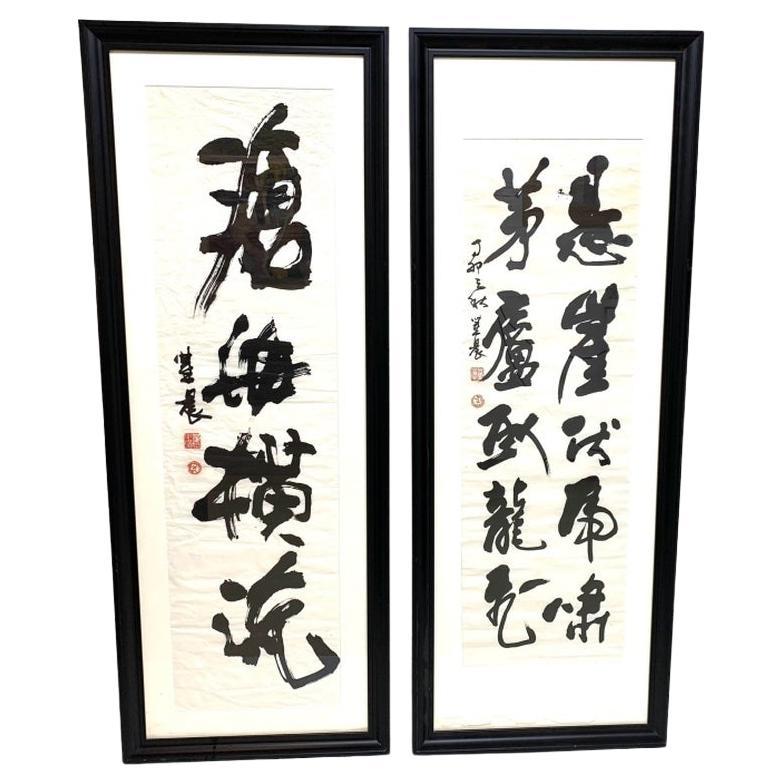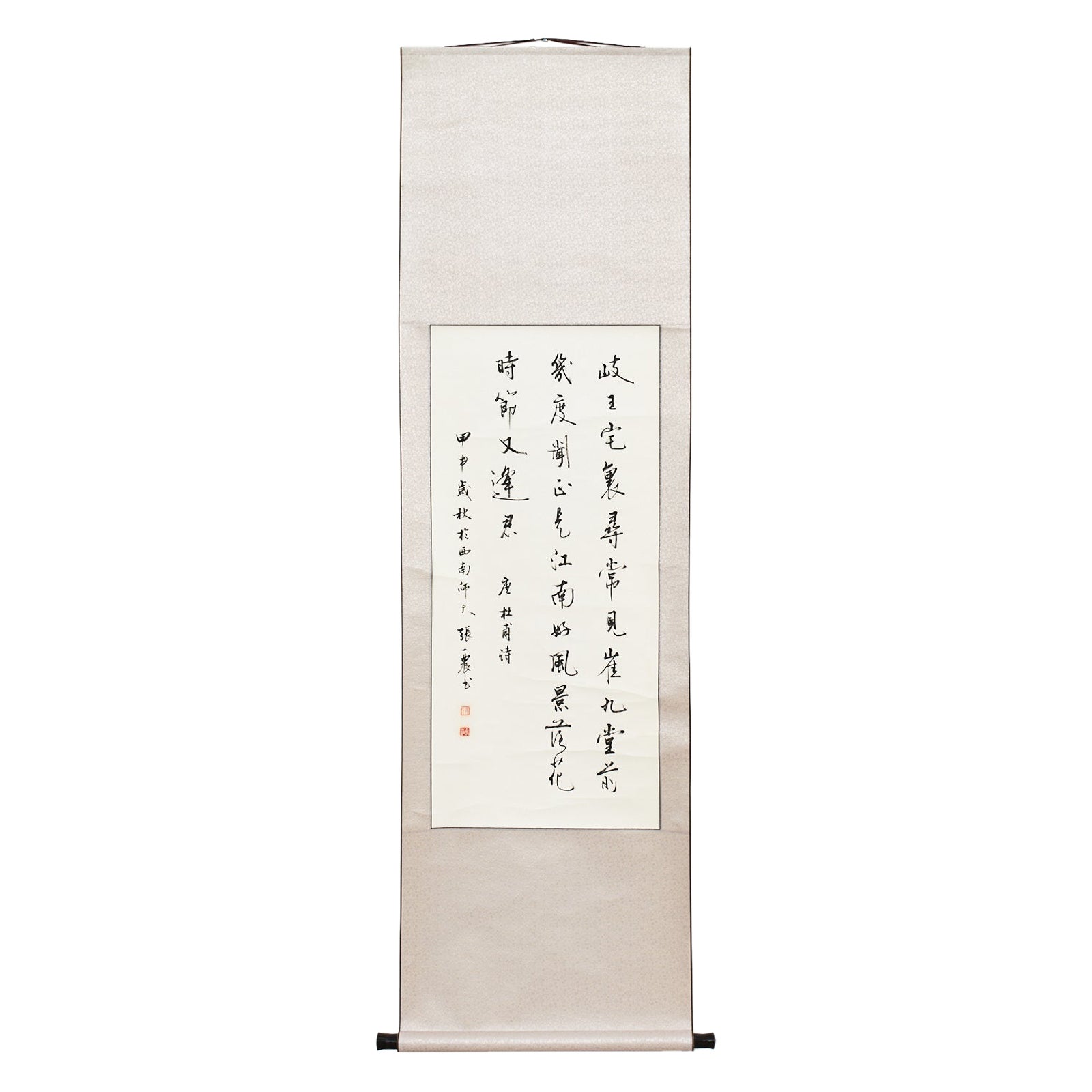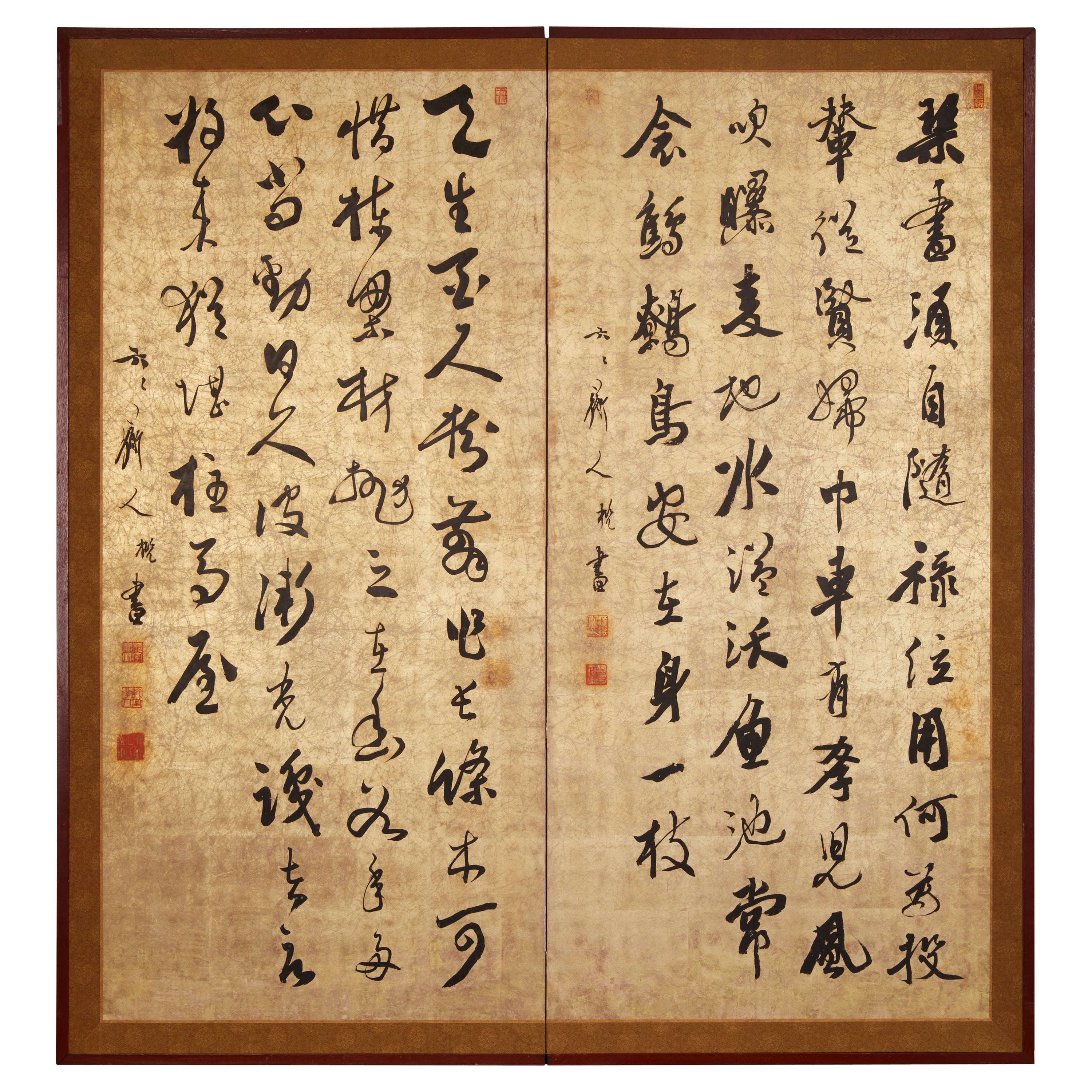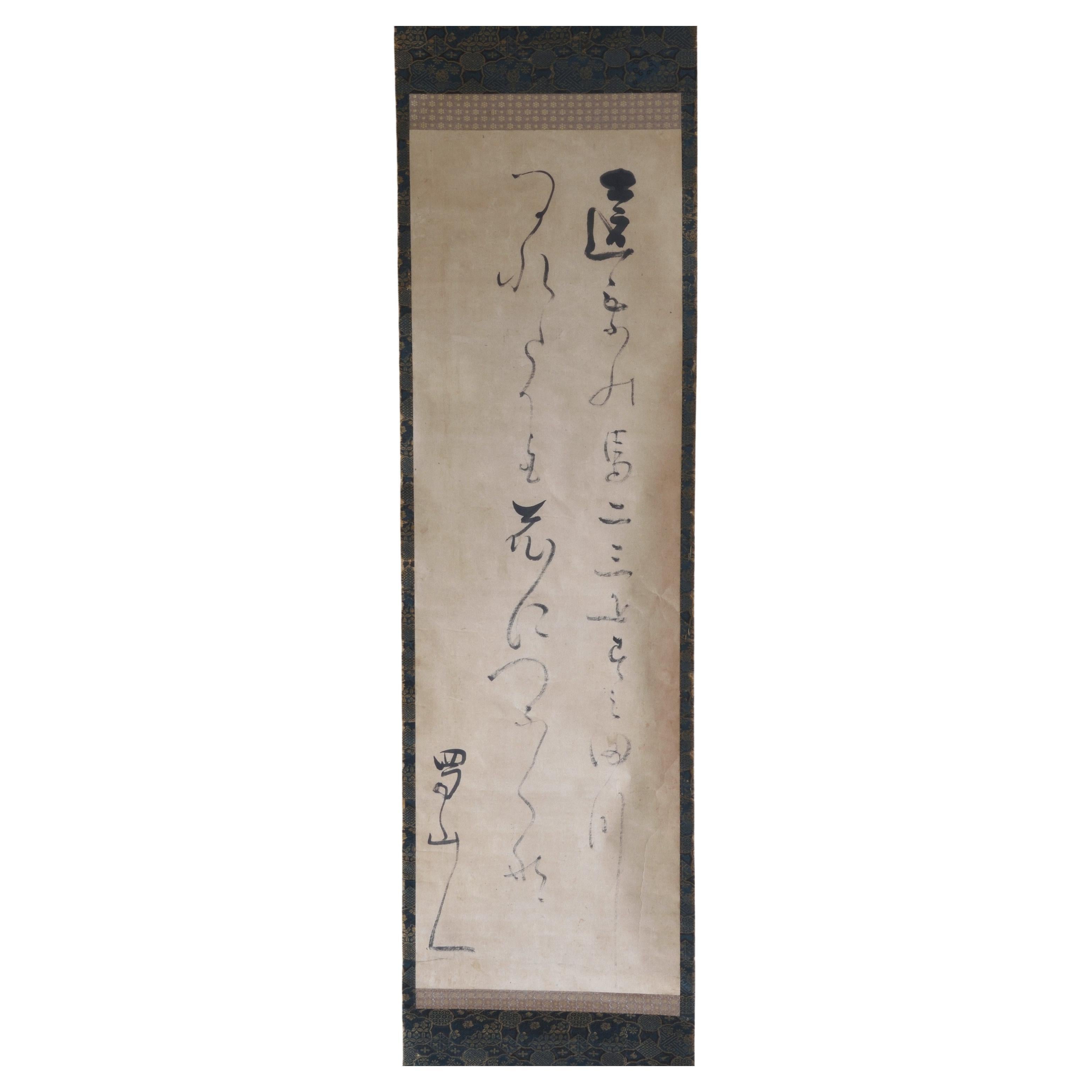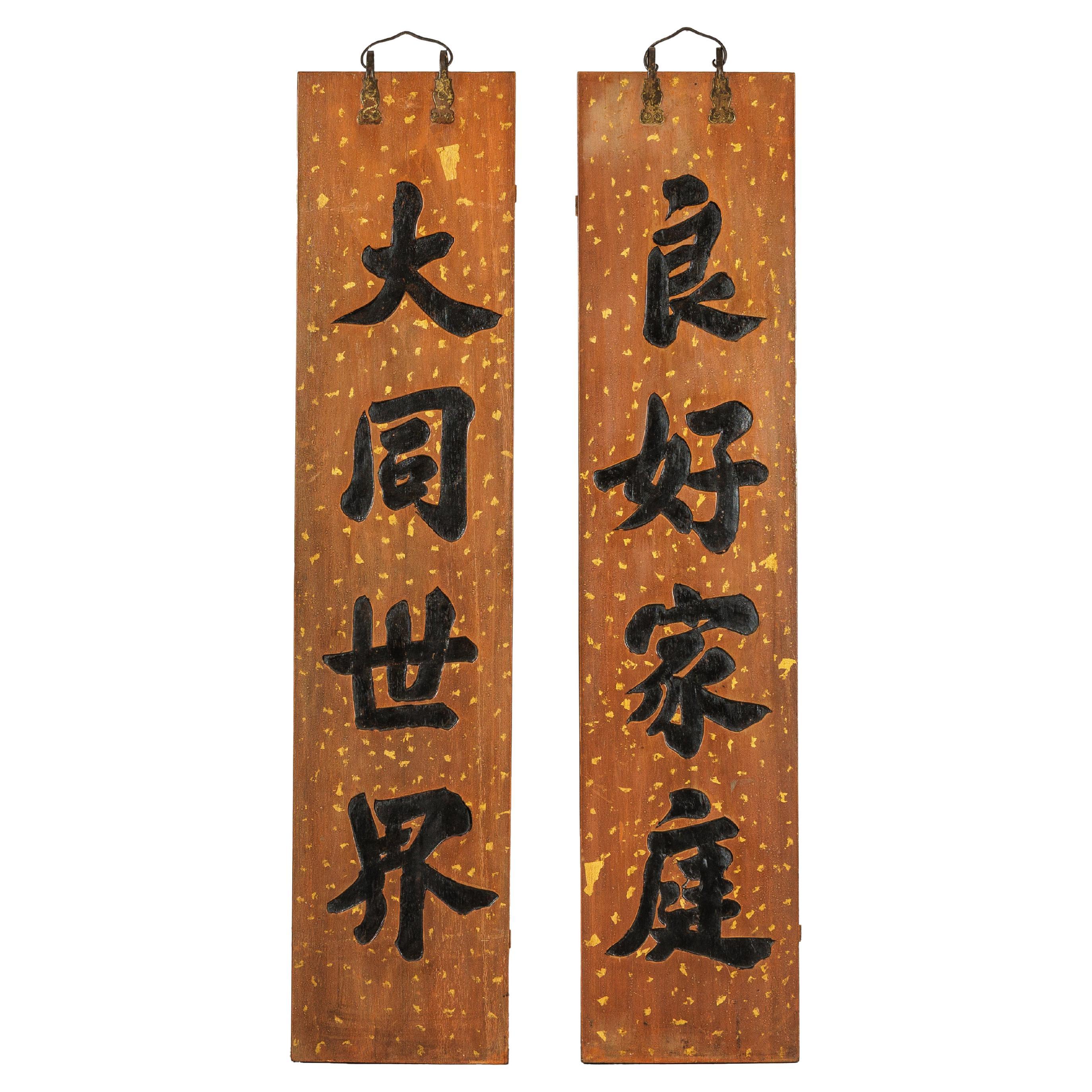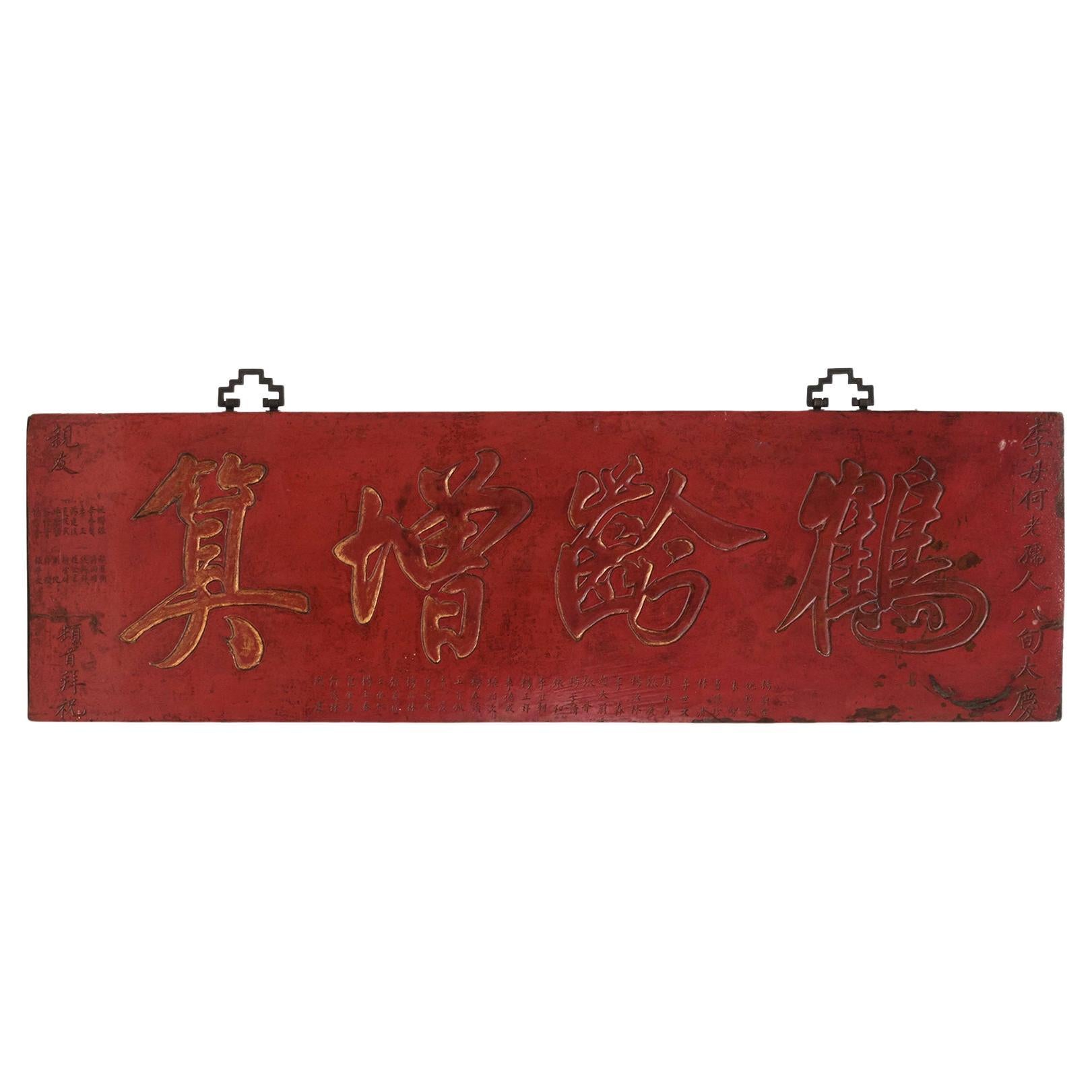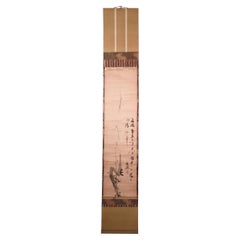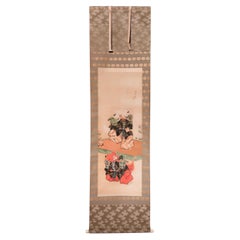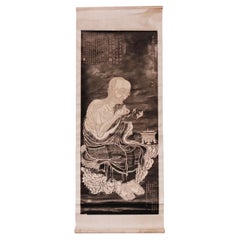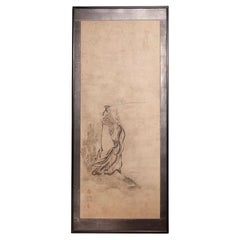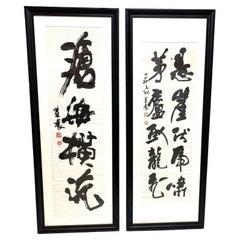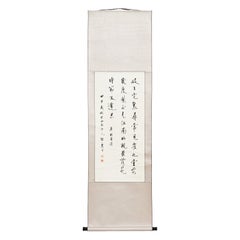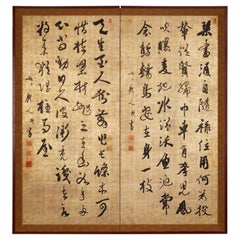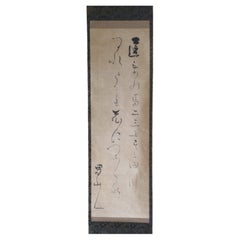Items Similar to Chinese Pair of Poetic Calligraphy Scrolls by Luo Er Dong Zhuang
Want more images or videos?
Request additional images or videos from the seller
1 of 6
Chinese Pair of Poetic Calligraphy Scrolls by Luo Er Dong Zhuang
$350per set
£264.90per set
€304.15per set
CA$498.60per set
A$540.75per set
CHF 284.02per set
MX$6,568.34per set
NOK 3,554.08per set
SEK 3,346.36per set
DKK 2,270.71per set
About the Item
Chinese Pair of Calligraphy Scrolls, vertical lines of calligraphy executed in a light style, right reading: “Moon Rises and the Candle has no Effect” and the left reading: “Wind Rises and the Fan looses its Duty” Signed Luo Er Dong Zhuang (Lo Erh Tung Chuang) with seals, mounted on white silk brocade, minor stain, creases, overall fine condition.
Each Measuring: 54 in. High x 13 in. Wide.
20th Century.
Provenance: Frank “Till” & Peggy Durdin, San Diego.
- Dimensions:Height: 54 in (137.16 cm)Width: 13 in (33.02 cm)Depth: 1 in (2.54 cm)
- Sold As:Set of 2
- Style:Other (Of the Period)
- Materials and Techniques:
- Place of Origin:
- Period:
- Date of Manufacture:20th Century
- Condition:Wear consistent with age and use. Minor stains, creases, overall fine condition.
- Seller Location:Point Richmond, CA
- Reference Number:Seller: TM-UA061701stDibs: LU1778241858392
About the Seller
5.0
Platinum Seller
Premium sellers with a 4.7+ rating and 24-hour response times
Established in 1999
1stDibs seller since 2015
712 sales on 1stDibs
Typical response time: 2 hours
- ShippingRetrieving quote...Shipping from: Palm Springs, CA
- Return Policy
Authenticity Guarantee
In the unlikely event there’s an issue with an item’s authenticity, contact us within 1 year for a full refund. DetailsMoney-Back Guarantee
If your item is not as described, is damaged in transit, or does not arrive, contact us within 7 days for a full refund. Details24-Hour Cancellation
You have a 24-hour grace period in which to reconsider your purchase, with no questions asked.Vetted Professional Sellers
Our world-class sellers must adhere to strict standards for service and quality, maintaining the integrity of our listings.Price-Match Guarantee
If you find that a seller listed the same item for a lower price elsewhere, we’ll match it.Trusted Global Delivery
Our best-in-class carrier network provides specialized shipping options worldwide, including custom delivery.More From This Seller
View AllJapanese ink on paper painting of Plum Blossoms, Tani Buncho
Located in Point Richmond, CA
Japanese ink on paper painting of Plum Blossoms and Poem, scroll mounting, signature & single seal: Tani Buncho (1763 - 1840). A famous and prol...
Category
Antique 19th Century Japanese Meiji Paintings and Screens
Materials
Paper
Japanese Noh/Kabuki Shakkyo painting, Torii Kiyotada
Located in Point Richmond, CA
Japanese colors, gofun and metallics on silk painting of Noh/Kabuki Dancers, depicting two figures of actors dancing in the play Shakkyo portraying a pair of shishi (lions), one on a...
Category
Early 20th Century Japanese Meiji Paintings and Screens
Materials
Silk
Antique Chinese Printed Ink Rubbing of Panthaka Arhat, (scroll mounted)
Located in Point Richmond, CA
Chinese ink rubbing printing depicting Panthaka Arhat, no.4 of the 16 arhat images immortalized in stone at the former stupa at Shengyin Temple. Depicted here sitting on a rock with a book in his left hand and snapping his fingers in his right hand, symbolic of the speed at which he obtained enlightenment, accompanied by a beggar’s bowl and an incense burner, complete with colophons and silk scroll mounting. The Emperor Qianlong ordered the stone stele to be carved in 1764 after the arhat designs painted by the famed artist Guanxiu (832-912). Even though the temple was destroyed in the Taiping rebellion, the steles remain and have been reinstalled at the Hangzhou Stele Forest. Condition: Creases from rolling, otherwise fine condition. Mounting: 58” x 22”. 19th Century. Ex Collection: Frank “Till” & Peggy Durdin, San Diego.
For other rubbings of this stele see:
Penn Museum, object number 2010-26-4
The Metropolitan Museum of Art AN#: 59.195.15
Fine Arts Library of Harvard University, record id: W280021_urn-3:FHCL:478850
For another example of this image rendered in jade and lacquer see: “Screen Paintings of Guanxiu’s Sixteen Arhats in the Collection of the Palace Museum” Luo Wehhua translated by Bruce Doar, Orientations, September 2010, p. 104. In this article the image is identified as the sixteenth arhat Abheda, It is explained in this article that Qianlong re-identified the arhats, thus the 16th Arhat attribution for this image. Also in this article the identical colophon by Qianlong above the image is translated as: “These accurate portraits of the Sixteen Arhats were created by the Tang Dynasty painter Guanxiu, as recorded in Xuanhe Huapu (Record of paintings in the Xuanhe Reign), and during the millennium from the Guangming reign period to the present day, the original works were to be found in Zhejiang, where they were housed in the collection of Shengyin Temple in Qiantang (Huangzhou). In spring of the dingchou year (1757) of his reign, the Qianlong emperor undertook a southern tour of inspection and stayed at an imperial lodge on the West Lake. He went to the temple to pay his respects and there he saw the arhats on display and wrote a description of these marvels. The sequence of the arhats and their names had been passed down since ancient times, but they did not correspond to their Sanskrit titles; the sequence of the arhat names conformed instead to the interpretation of the Sanskrit classics by the Zhangjia State Preceptor. The emperor penned the original names and positions in the sequence below each of the figures in accordance with the readings supplied in Tongwen Yuntong (Unified Rhymes), and below each he penned an encomium, which he signed. Then the images were returned to the collection, to be passed down as a perpetual treasure. Now, the fourth great arhat had long gone missing and we did not know where his painting was. But it was merely a trifling matter of matching the images with the names, and now surely we have found him! This I, the emperor, believe.”
All 16 of these rubbings can be found in the Rubel Chinese Rubbings Collection at the Fine Arts Library of Harvard University with the following descriptive historical note: “Rubbing from stele depicting No. 4 of 16 arhats (Lohans, Buddhist saints) -- Nan ti mi duo luo qing you, Panthaka Arhat. Original painting attributed to Guanxiu, 832-912. Inscriptions written by Hongli, Emperor Qianlong (Gaozong, 1711-1799) of Qing Dynasty. 7 seals of Qianlong follow the inscriptions. Script style: in xing shu. Shi liu zun zhe -- "The 16 noble ones" are 16 lohans. Lohans are also called "a-lo-han" based on the transliteration of the Sanskrit term "arhat." (Japanese: Rakan; Chinese: Lohan; Tibetan: Gnas-brtan). Arhats or Arahants are saints or sages said to have renounced nirvana (freedom from the cycle of suffering and rebirth), vowed to remain in the world to protect the Dharma and propagate the Law of the Buddha in order to devote themselves more effectively to the relief of human misery, like the Bodhisattvas. These 16 Arhats, personal disciples distinguished by the Buddha, formed part of the 500 claimed by tradition to have attended the First Council in Rajagrha. The names and abodes of these 16 arhats are given in a work entitled "Record on the Duration of the Law, spoken by the Great arhat Nadimitra," which was translated into Chinese by the famous pilgrim Xuanzang (596-664) in 654. 16 lohans are quite often represented, especially in China and Japan, in sculpture and painting, in poses and with attributes. Every lohan can be easily with special icongraphic characteristics. Guanxiu (Jiang Deyin or Deyuan, a Buddhist monk also named Master Chan Yue, 832-912) -- painter during late Tang to Five Dynasties, specialized in painting lohan figures. Legend has it that the first portraits of the 18 Lohans...
Category
Antique 19th Century Chinese Qing Prints
Materials
Paper
Antique Japanese Suibokuga Sage by Kano Tokinobu, 17th century.
Located in Point Richmond, CA
Antique Japanese Suibokuga Sage Painting by Kano Tokinobu, 17th century. A sumi-e ink on paper painting illustrating an acolyte at a riverbank. The image of the standing Chinese figure with elongated earlobes (a symbol of enlightenment), hair tied back in a kerchief and long beard, holds a large fan in his left hand to his right shoulder. The long robes are windswept with water curls about the figures feet. The painting with 3 vermillion seals of the artist in the lower left corner. Japanese dry mount paper on a wood frame with thin brocade border silver leafed surround and lacquered wood outer frame.
Condition: Paper restoration on center, a quarter of an inch of the left edge of the painting is added, other minor signs of age, wear, stains and repairs overall fine condition.
Age: Painting Edo Period, circa 1670. Mounting circa 1985.
Image: 51-1/2 in. x 20-1/2 in. (131cm x 52cm)
Frame: 59-1/4 in. x 25-1/4 in. (150cm x 64cm)
Weight: 6lbs.
Provenance:
with Honeychurch Antiques...
Category
Antique 1670s Japanese Edo Paintings and Screens
Materials
Paper
Antique Burmese Gilt Lacquered Kammavaca Manuscript
Located in Point Richmond, CA
Antique Burmese Gilt Lacquered Kammavaca Manuscript, Consisting of 2 lacquered wood end covers and 16 double sided folios of lacquered cloth in red and black with gold leaf. This Kam...
Category
Antique 19th Century Burmese Other Lacquer
Materials
Gold Leaf
Antique Japanese Suibokuga Landscape by Kano Tokinobu, 17th century.
Located in Point Richmond, CA
Antique Japanese Suibokuga Landscape by Kano Tokinobu, 17th century. A sumi-e ink on paper painting illustrating a rocky seaside landscape containing buildings, vegetation and ship masts. The painting with 3 vermillion seals of the artist in the lower left corner. Japanese dry mount paper on a wood frame with thin brocade border silver leafed surround and lacquered wood outer frame.
Condition: Lighter discoloration near the bottom of the painting, various paper restorations, other minor signs of age, wear, stains, otherwise fine condition.
Age: Painting Edo Period, circa 1670. Mounting circa 1985.
Image: 51-1/2 in. x 20-1/2 in. (131cm x 52cm)
Frame: 59-1/4 in. x 25-1/4 in. (150cm x 64cm)
Weight: 6 lbs.
Provenance:
with Honeychurch Antiques...
Category
Antique 1670s Japanese Edo Paintings and Screens
Materials
Paper
You May Also Like
Pair of Chinese Calligraphy Scrolls in Mark Humphrey Gallery Frames
Located in Bridgeport, CT
A pair of boldly brushed Rice Paper Calligraphy Panels having a particularly fine Asian presentation. One panel with 10 Calligraphic characters and the other with 4 and both with red...
Category
20th Century Asian Ming Paintings and Screens
Materials
Wood, Paper
Chinese Hanging Scroll Pair of Poetic Couplets Signed
Located in Rio Vista, CA
Large Chinese hanging scroll having a pair of poetic couplets with a cyclical date autumn 1944/2004 Jishen and signed Zhang with 2 seals. The sight mea...
Category
21st Century and Contemporary Chinese Qing Paintings and Screens
Materials
Silk, Wood, Paper
Japanese Two Panel Screen: Ink Calligraphy Poem of the Moon
Located in Hudson, NY
Poems refer to moon gazers. Ink on mulberry paper with a silk brocade border. Seals read: Roku-roku sai.
Category
Antique 19th Century Japanese Paintings and Screens
Materials
Brocade, Silk, Paper
19th century Edo-period Japanese Hanging Scroll Calligraphy of Mad Poetry
Located in Chiba, JP
Hanging scroll with such unstrained and refined calligraphy of ‘Kyoka’ (lit. ‘Mad poetry’ – Humorous style of Japanese tanka poetry with joke or irony or satire) by a late Edo-period...
Category
Antique 19th Century Japanese Edo Antiquities
Materials
Brocade, Wood, Paper
Pair of Chinese 1920s Lacquered Calligraphy Signs with Hand-Carved Characters
Located in Yonkers, NY
This pair of vertical Chinese signs, dating to the early 20th century, is richly decorated with bold hand-carved calligraphy. Each panel is crafted from wood and finished in a warm l...
Category
Early 20th Century Chinese Sculptures and Carvings
Materials
Wood
Mid-19th Century Chinese Calligraphy Sign Board
Located in Kastrup, DK
A Chinese Qing Dynasty period red lacquered signboard with calligraphy.
The wood carved signboard showcases large carved Chinese characters with remnants of gold leaf, flanked wit...
Category
Antique Mid-19th Century Chinese Qing Decorative Art
Materials
Metal
More Ways To Browse
Pair Of Chinese Paintings
Chinese Scroll Art
Chinese Scroll Paintings
Chinese Paper Scroll
Calligraphy Scroll
Mother Of Pearl Panel
Chinese Four Panel Lacquer Screen
Ebonized Japanese
Asian Screen Vintage
Silk Screen Artists
Vintage Asian Screens
Asian Bird Paintings
Chinese Reverse Painted Glass
Japanese Taisho Screen
Silver Japanese Painting
Pair Of Chinese Paintings
Chinese Screens Carved Wood
Japanese Edo Period Screens
